Database Plugin - Macros - Delete DbUnit¶
Contents :
# DELETE_DBUNIT {dataset} FROM {database}¶
What ?
This macro will delete all the data listed in the ‘dataset file’ from the ‘database’.
Underlying instructions :
LOAD {dataset} AS __temp_{%%rand1}.file
CONVERT __temp_{%%rand1}.file TO xml(structured) AS __temp_{%%rand2}.xml
CONVERT __temp_{%%rand2}.xml TO dataset.dbunit(dataset) AS __temp_{%%rand3}.dbu
EXECUTE delete WITH __temp_{%%rand3}.dbu ON {database} USING $(operation : delete) AS __temp_{%%rand4}.result
> Input :
database}: The name (in the context) of the database to use (databasetype target).{dataset}: A flat xml dbunit dataset file.
Remark : The file designed by {dataset} must respect the same rules than a file which would serve to create an SKF dataset.dbunit type resource via the converter (From xml to dataset.dbunit).
Example :
# DELETE_DBUNIT path/to/dataset.xml FROM my_database Database overview :
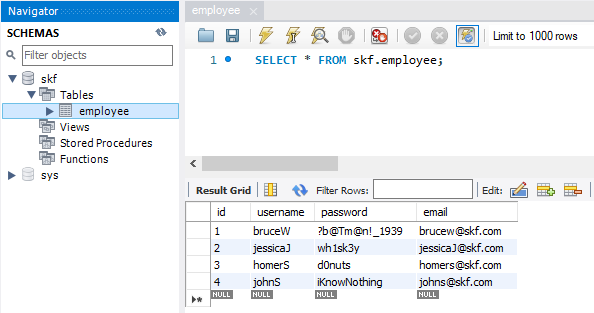
Dataset .xml File :

SKF script :

There is only one employee left in the database :
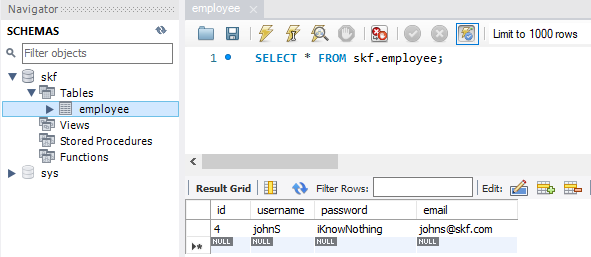
# DELETE_DBUNIT {dataset} FROM {database} WITH CONFIG {config}¶
What ?
This macro will delete all the data listed in the ‘dataset file’ from the ‘database’ using a DbUnit configuration file.
Underlying instructions :
LOAD {config} AS __temp{config}{%%rand1}.file
CONVERT __temp{config}{%%rand1}.file TO conf.dbunit AS __temp{config}{%%rand2}.conf
LOAD {dataset} AS __temp_{%%rand3}.file
CONVERT __temp_{%%rand3}.file TO xml(structured) AS __temp_{%%rand4}.xml
CONVERT __temp_{%%rand4}.xml TO dataset.dbunit(dataset) AS __temp_{%%rand5}.dbu
EXECUTE delete WITH __temp_{%%rand5}.dbu USING $(operation : delete),__temp{config}{%%rand2}.conf ON {database} AS __temp_{%%rand6}.result
> Input :
{database}: The name (in the context) of the database to use (databasetype target).{dataset}: A flat xml dbunit dataset file.{config}: A configuration file for DbUnit (‘.properties’).
Remarks :
- The file designed by
{dataset}must respect the same rules than a file which would serve to create an SKFdataset.dbunittype resource via the converter (From xml to dataset.dbunit).- The file designed by
{config}must respect the same rules than a file which would serve to create an SKFconf.dbunittype resource via the converter (From file to conf.dbunit).
Example :
# DELETE_DBUNIT path/to/dataset.xml FROM my_database WITH CONFIG path/to/my_config_dbunit.properties
# DELETE_DBUNIT {dataset} FROM {database} USING {ppkfilter}¶
What ?
This macro will load the specified xml dataset and delete datas listed in from the ‘database’ using a filter DbUnit.
Underlying instructions :
// Load and convert the dbunit dataset
LOAD {dataset} AS __{%%r1}.file
CONVERT __{%%r1}.file TO file(param.relativedate) AS __{%%r2}.file
CONVERT __{%%r2}.file TO xml(structured) AS __{%%r3}.xml
CONVERT __{%%r3}.xml TO dataset.dbunit(dataset) AS __{%%r4}.dbu
// Load and convert the pseudo primary key filter
LOAD {ppkfilter} AS __{%%r5}.file
CONVERT __{%%r5}.file TO properties(structured) AS __{%%r6}.props
CONVERT __{%%r6}.props TO conf.dbunit.ppk(from.properties) AS __{%%r7}.ppk
// Execute delete operation using the pseudo primary key filter
EXECUTE delete WITH __{%%r4}.dbu ON {database} USING __{%%r7}.ppk,$(operation : delete) AS __{%%r8}.result
> Input :
{database}: The name (in the context) of the database to use (databasetype target).{dataset}: A flat xml dbunit dataset file.{ppkfilter}: A DbUnit filter referring to pseudo primary keys (‘.properties’).
Example :
# DELETE_DBUNIT path/to/dataset.xml FROM my_database USING path/to/my_filter_dbunit.properties For this example, we set the table employee with no primary key :
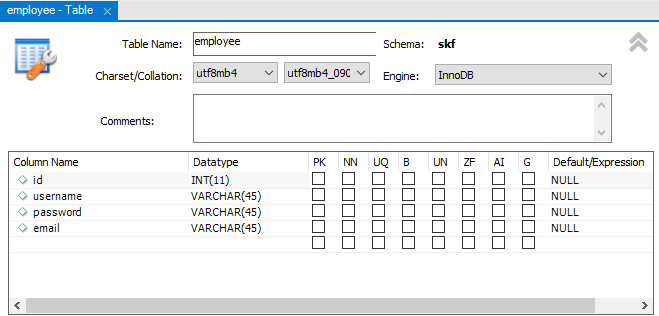
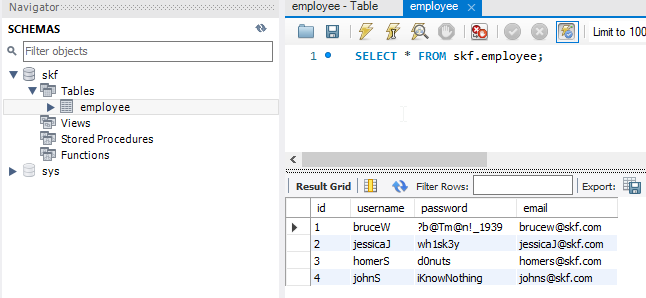
We set “username” as pseudo primary key in properties file :

Dataset .xml file :

We execute the macro without using ppk properties file :

The following error occurs :

We execute the macro with the ppk properties file :

The operation succeeds and all employees are deleted :

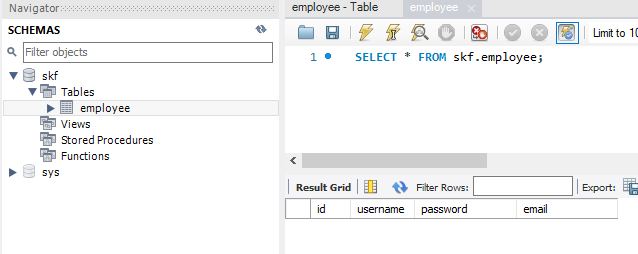
# DELETE_ALL_DBUNIT {dataset} FROM {database}¶
What ?
This macro will load the specified xml dataset and truncate every table listed in from the ‘database’.
Underlying instructions :
LOAD {dataset} AS __temp_{%%rand1}.file
CONVERT __temp_{%%rand1}.file TO xml(structured) AS __temp_{%%rand2}.xml
CONVERT __temp_{%%rand2}.xml TO dataset.dbunit(dataset) AS __temp_{%%rand3}.dbu
EXECUTE delete WITH __temp_{%%rand3}.dbu ON {database} AS __temp_{%%rand4}.result
> Input :
{database}: The name (in the context) of the database to use (databasetype target).{dataset}: A flat xml dbunit dataset file.
Remark : The file designed by {dataset} must respect the same rules than a file which would serve to create an SKF dataset.dbunit type resource via the converter (From xml to dataset.dbunit).
Example :
| # DELETE_ALL_DBUNIT path/to/dataset.xml FROM my_database |
# DELETE_ALL_DBUNIT {dataset} FROM {database} WITH CONFIG {config}¶
What ?
This macro will load the specified xml dataset and truncate every table listed in from the ‘database’ using a DbUnit configuration file.
Underlying instructions :
LOAD {config} AS __temp{config}{%%rand1}.file
CONVERT __temp{config}{%%rand1}.file TO conf.dbunit AS __temp{config}{%%rand2}.conf
LOAD {dataset} AS __temp_{%%rand3}.file
CONVERT __temp_{%%rand3}.file TO xml(structured) AS __temp_{%%rand4}.xml
CONVERT __temp_{%%rand4}.xml TO dataset.dbunit(dataset) AS __temp_{%%rand5}.dbu
EXECUTE delete WITH __temp_{%%rand5}.dbu USING __temp{config}{%%rand2}.conf ON {database} AS __temp_{%%rand6}.result
> Input :
{database}: The name (in the context) of the database to use (databasetype target).{dataset}: A flat xml dbunit dataset file.{config}: A configuration file for DbUnit (‘.properties’).
Remarks :
- The file designed by
{dataset}must respect the same rules than a file which would serve to create an SKFdataset.dbunittype resource via the converter (From xml to dataset.dbunit).- The file designed by
{config}must respect the same rules than a file which would serve to create an SKFconf.dbunittype resource via the converter (From file to conf.dbunit).
Example :
| # DELETE_ALL_DBUNIT path/to/dataset.xml FROM my_database WITH CONFIG path/to/my_config_dbunit.properties |